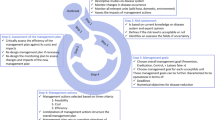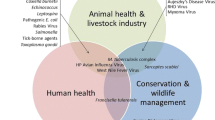Abstract
Disease risk analysis (DRA) is a process for identifying significant disease risks and proposing measures to mitigate those risks. Although numerous methodologies for DRA exist, the IUCN Disease Risk Analysis Manual Jakob-Hoff et al. (World Organisation for Animal Health, Paris, pp 160, 2014) remains the gold standard for wild animal translocations. In some cases, however, constraints of time or resources demand compromises on the ideal methodology, and a cost–benefit assessment is required to determine the best approach. We propose a methodology modified from Jakob-Hoff et al. (World Organisation for Animal Health, Paris, pp 160, 2014) and Sainsbury and Vaughan-Higgins (Conserv Biol 26:442–452, 2012), using translocations of the Shark Bay bandicoot (SBB) (Perameles bougainville) as an example. In this study, 44 hazards were identified and described for Peramelidae species. We used hazard prioritization and “scoping” to develop a shortlist of hazards for detailed risk assessment, which excluded 35 of these hazards from further assessment. This approach enabled timely, efficient and cost-effective completion of the DRA while maintaining transparent evaluation of all disease risks. We developed a disease risk management strategy for SBB based on structured, evidence-based analysis of current information and established biosecurity practices and disease screening recommendations for future translocations. Our approach demonstrates a practical process for DRA and risk mitigation, which delivered management outcomes despite limited resources, variable knowledge of disease epidemiology and uncertain translocation pathways for the target species. Limitations are acknowledged, and further research will aim to objectively test this methodology compared to other available methods.
Similar content being viewed by others
References
Armstrong D, Jakob-Hoff R, Seal U (2003) Animal movements and disease risk: a workbook. IUCN/SSC Conservation Breeding Specialist Group, Apple Valley, Minnesota.
Australian Registry of Wildlife Health (2018) Database. Taronga Conservation Society Australia. Available online: https://arwh.org/australian-registry-of-wildlife-health
Bennett MD (2008) Western barred bandicoots in health and Disease. PhD Thesis Murdoch University. Available online: http://researchrepository.murdoch.edu.au/id/eprint/474/2/02Whole.pdf
Bobadilla Suarez M, Ewen JG, Groombridge JJ, Beckmann K, Shotton J, Masters N, Hopkins T, Sainsbury AW (2015) Using qualitative disease risk analysis for herpetofauna conservation translocations transgressing ecological and geographical barriers. Ecohealth 14:47–60
Brown MJF, Sainsbury AW, Vaughan- Higgins RJ, Measures GH, Jones CM, Gammans N (2016) Bringing back a healthy buzz? Invertebrate parasites and reintroductions: a case study in bumblebees. EcoHealth 14:74–83. https://doi.org/10.1007/s10393-015-1093-5
Caughley G, Gunn A (1996) Conservation biology in theory and practice. Oxford, UK: Blackwell Science
Cooney R (2004) The Precautionary Principle in Biodiversity Conservation and Natural Resource Management: An issues paper for policy-makers, researchers and practitioners. IUCN, Gland, Switzerland and Cambridge, UK. xi + 51pp.
Dalziel A, Sainsbury T, McInnes K, Jakob-Hoff R, Ewen J (2017) A comparison of disease risk analysis tools for conservation translocations. Ecohealth 14:30–41
Davidson WR, Nettles VF (1992) Relocation of wildlife: identifying and evaluating disease risks. Trans N Am Wildl Nat Res Conf 57:466–473
Dickens MJ, Delehanty DJ, Romero ML (2010) Stress: an inevitable component of animal translocation. Biol Conserv 143:1329–1341
Dunlop J (2015) The ecology and host parasite dynamics of a fauna translocation in Australia. PhD thesis. Murdoch University, Australia.
Environmental Protection and Biodiversity Conservation Act (1999) Available online: http://www.environment.gov.au/epbc
Ewen JG, Armstrong DP, Parker KA (2012) Reintroduction Biology: Integrating Science and Management. Wiley, New York.
Gallana M, Ryser-Degiorgis MP, Wahli T, Segner H (2013) Climate change and infectious diseases of wildlife: Altered interactions between pathogens, vectors and hosts. Curr Zool 59:427–437
Hartley M, Sainsbury A (2017) Methods of disease risk analysis in wildlife translocations for conservation purposes. Ecohealth 14:16–29
IUCN (2013). Guidelines for Reintroductions and Other Conservation Translocations. Version 1.0. Gland, Switzerland: International Union for Conservation of Nature, Species Survival Commission, viiii + 57 pp.
IUCN (2018). The IUCN Red List of Threatened Species. Version 2018–2. http://www.iucnredlist.org. Downloaded on 14 March 2020.
Jakob-Hoff RM, MacDiarmid SC, Lees C, Miller PS, Travis D, Kock R. (2014a). Manual of procedures for wildlife disease risk analysis. World Organisation for Animal Health, Paris, 160pp. Published in association with the International Union for Conservation of Nature Species Survival Commission.
Jakob-Hoff R, Carraro C, Sainsbury AW, Ewen J, Canessa S, (Eds) (2014b) Regent
Honeyeater Disease Risk Analysis. IUCN SSC Conservation Breeding Specialist Group: Apple Valley, MN.
Jakob-Hoff R, Coetsee A, Bodley K, Lynch M (2016) Disease risk analysis for the proposed translocation of eastern barred bandicoots to French and Phillip Islands. Apple Valley, MN: IUCN SSC Conservation Breeding Specialist Group
Kock RA, Woodford MH, Rossiter PB (2010) Disease risks associated with the translocation of wildlife. Revue Scientifique et Technique Office International des Epizooties (OIE) 29:329–350
McGill I, Feltrer Y, Jeffs C, Sayers G, Marshall RM, Peirce MA, Stidworthy MP, Pocknell AM, Sainsbury AW (2010) Isosporoid coccidiosis in translocated cirl buntings (Emberiza cirlus). Veterinary Record 167:656–660
McInnes K (2011) Translocation Disease Risk Management Process. Wellington, New Zealand: New Zealand Department of Conservation
Ministry of Agriculture and Forestry (2006) Biosecurity New Zealand. Risk Analysis Procedures. Available: https://www.mpi.govt.nz/dmsdocument/2031-risk-analysis-procedures
Morris K, Page M, Kay R, Renwick J, Desond A, Comer S, Burbidge A, Kuchling G, Sims C (2015) Forty years of fauna translocations in Western Australia: lessons learned. In: Armstrong DP, Hayward MW, Moro D, Seddon PJ (eds) Advances in Reintroduction Biology of Australian and New Zealand fauna Melbourne: CSIRO Publishing, pp 217–237
Murray N (2002) Import Risk Analysis. Animals and Animal Products: New Zealand Ministry of Agriculture and Forestry, p 183
Nally S, Adams L (2015) Evolution of the translocation approval process in Australia and New Zealand. In: Armstrong DP, Hayward MW, Moro D, Seddon PJ (eds) Advances in Reintroduction Biology of Australian and New Zealand fauna Melbourne: CSIRO Publishing, pp 273–285
Preece N, Abell S, Grogan L, Wayne A, Skerratt L, Van Oosterzee P, Shima A, Daszak P, Field H, Reiss A, Berger L, Rymer T, Fisher D, Lawes M, Laurance S, McCallum H, Esson C, Epstein J (2017) A guide for ecologists: Detecting the role of disease in faunal declines and managing population recovery. Biol Conserv 214:136–146. https://doi.org/10.1016/j.biocon.2017.08.014
Richards JD, Short J (2003) Reintroduction and establishment of the western barred bandicoot Perameles bougainville (Marsupialia: Peramelidae) at Shark Bay, Western Australia. Biol Conserv 109:181–195
Richards J (2012) Western barred bandicoot (Perameles bougainville), burrowing bettong (Bettongia lesueur ) and banded-hare wallaby (Lagostrophus fasciatus) National Recovery Plan. Wildlife Management Program No. 49. Available: https://www.environment.gov.au/system/files/resources/d6531fe5-166f-4202-a36e-3ad37a3ac5cf/files/shark-bay-marsupials.pdf
Ryndock E, Robison R, Meters C (2016) Susceptibility of HPV16 and 18 to high level disinfectants indicated for semi-critical ultrasound probes. J Med Virol 88:1076–1080
Sainsbury AW, Armstrong DP, Ewen JG (2012) Methods of disease risk analysis for reintroduction programmes. In: Ewen JG, Armstrong DP, Parker KA, Seddon PJ (eds) Reintroduction biology: integrating science and management Oxford: Wiley-Blackwell, pp 336–359
Sainsbury AW, Vaughan-Higgins RJ (2012) Analysing disease risks associated with translocations. Conserv Biol 26:442–452
Shark Bay Mammal Recovery Team (2017) Recovery Action 4, Minutes of the Shark Bay Mammal Recovery Team. 24 November 2017, Milyu Room, Kensington, DBCA.
Short J (2009) The characteristics and success of vertebrate translocations within Australia. Fisheries and Forestry, Canberra: Final report to Department of Agriculture
Tompkins D, Carver S, Jones M, Krkos M, Skerratt L (2015) Emerging infectious diseases of wildlife: a critical perspective. Special issue: wildlife parasitology. Trends Parasitol 31(4):149–159
UNESCO (1991). World Heritage Committee: Fifteenth session. United Nations Educational, Scientific and Cultural Organization. Convention concerning the protection of the world cultural and natural heritage, Carthage.
Vaughan-Higgins R, Masters N, Sainsbury T (2017) Biosecurity for Translocations: Cirl Bunting (Emberiza cirlus), Fisher’s Estuarine Moth (Gortyna borelil lunata), Short-Haired Bumblebee (Bombus subterraneus) and Pool frog (Pelophylax lessonae) Translocations as Case Studies. Ecohealth 14:84–91
Vaughan-Higgins RJ (2019) Disease Risk Analysis for Translocations Chapter 3. In: Portas T, Vogelnest L (eds) Medicine of Australian Mammals, vol 2. Collingwood: CSIRO Publishing, pp 37–50
Vaughan-Higgins RJ, Vitali S, Reiss A (2019) Disease Risk Analysis for the Shark Bay Bandicoot (Perameles bougainville) Internal document Perth Zoo Veterinary Department, Department of Biodiversity, Conservation and Attractions.
Walker S, Bosch FJ, James TY, Litvintseva APJ, Pina S, Garcıia G, Rosa GA, Cunningham AA, Hole S, Griffiths R, Fisher M (2008) Invasive pathogens threaten species recovery programs. Curr Biol 18:853–854
Warren K, Swan R, Bodetti T, Friend T, Hill S, Timms P (2005) Ocular Chlamydiales infections of Western Barred Bandicoot (Perameles bougainville) in Western Australia. J Zoo Wildl Med 36:100–102
Woolford L (2007) Protocol for working with Perameles bougainville on Bernier and Dorre Islands. Standard Operating Procedure. Department of Biodiversity Conservation and Attractions. Internal Document.
Woolford, Lucy (2008) Papillomatosis and carcinomatosis in the western barred bandicoot (Perameles bougainville).PhD thesis, Murdoch University. Available online: http://researchrepository.murdoch.edu.au/id/eprint/673/
Woodford MH, Rossiter PB. Disease risks associated with wildlife translocation projects. Rev Sci Tech. 1993;12(1):115–35. https://doi.org/10.20506/rst.12.1.667
Woolford L, Bennett MD, Sims C, Thomas N, Friend JA, Nicholls PK, Warren KS, O’Hara AJ (2009) Prevalence, emergence, and factors associated with a viral papillomatosis and carcinomatosis syndrome in wild, reintroduced, and captive western barred bandicoots (Perameles bougainville). Ecohealth 3:414–425
Acknowledgements
The authors would like to thank Wildlife Health Australia for facilitating provision of data from the national Wildlife Health Information System (eWHIS). Wildlife health data were provided by the WA Department of Primary Industries and Regional Development, the Tasmanian Department of Primary Industries, Parks, Water and Environment, Perth Zoo, the University of Melbourne, Territory Wildlife Park and The Ark Animal Hospital. The authors would also like to thank The Australian Registry of Wildlife Health for facilitating provision of data from their pathology database.
Author information
Authors and Affiliations
Corresponding author
Rights and permissions
About this article
Cite this article
Vaughan-Higgins, R.J., Vitali, S.D., Sims, C. et al. Streamlining Disease Risk Analysis for Wildlife Using the Shark Bay Bandicoot as a Model. EcoHealth 18, 13–30 (2021). https://doi.org/10.1007/s10393-021-01521-3
Received:
Revised:
Accepted:
Published:
Issue Date:
DOI: https://doi.org/10.1007/s10393-021-01521-3




